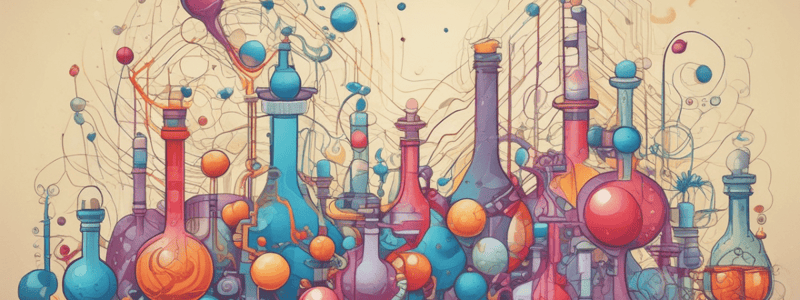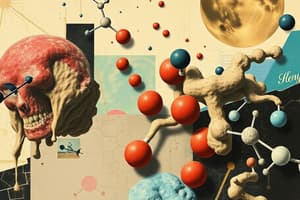Podcast
Questions and Answers
What is the approximate percentage of dry mass of most cells that proteins account for?
What is the approximate percentage of dry mass of most cells that proteins account for?
- 50% (correct)
- 30%
- 70%
- 20%
What is the type of bond formed between amino acids in a polypeptide chain?
What is the type of bond formed between amino acids in a polypeptide chain?
- Hydrogen bond
- Ionic bond
- Peptide bond (correct)
- Covalent bond
What is the function of the dehydration reaction in amino acid polymerization?
What is the function of the dehydration reaction in amino acid polymerization?
- To remove a hydroxyl group from the carboxyl end of one amino acid and a hydrogen atom from the amino group of another (correct)
- To add a hydroxyl group to the carboxyl end of an amino acid
- To break peptide bonds
- To add a hydrogen atom to the amino group of an amino acid
What is the term for the end of a polypeptide chain with a free amino group?
What is the term for the end of a polypeptide chain with a free amino group?
How many amino acids are there from which all protein molecules are made?
How many amino acids are there from which all protein molecules are made?
What is the central atom in an amino acid molecule?
What is the central atom in an amino acid molecule?
What type of bond forms between amino acids in a peptide?
What type of bond forms between amino acids in a peptide?
Which end of an amino acid polymer is represented by the group NH2?
Which end of an amino acid polymer is represented by the group NH2?
What is the term for amino acids that cannot be synthesized by the body and must be obtained through the diet?
What is the term for amino acids that cannot be synthesized by the body and must be obtained through the diet?
What is the functional group found at the Carboxyl end of an amino acid polymer?
What is the functional group found at the Carboxyl end of an amino acid polymer?
What is the function of essential amino acids in the human body?
What is the function of essential amino acids in the human body?
Which of the following amino acids is an example of a semi-essential amino acid?
Which of the following amino acids is an example of a semi-essential amino acid?
What is the term for the repeating pattern of atoms in the backbone of an amino acid polymer?
What is the term for the repeating pattern of atoms in the backbone of an amino acid polymer?
What type of reaction occurs between amino acids to form a peptide bond?
What type of reaction occurs between amino acids to form a peptide bond?
What is the classification of amino acids based on their chemical properties?
What is the classification of amino acids based on their chemical properties?
What is the functional group found at the Amino end of an amino acid polymer?
What is the functional group found at the Amino end of an amino acid polymer?
Which of the following proteins is an example of a transport protein?
Which of the following proteins is an example of a transport protein?
What is the function of non-essential amino acids in the human body?
What is the function of non-essential amino acids in the human body?
What is the term for amino acids that can be synthesized by the body and do not need to be obtained through the diet?
What is the term for amino acids that can be synthesized by the body and do not need to be obtained through the diet?
What is the classification of proteins based on their composition?
What is the classification of proteins based on their composition?
Which of the following proteins is an example of a genetic protein?
Which of the following proteins is an example of a genetic protein?
How many amino acids are classified as non-essential amino acids?
How many amino acids are classified as non-essential amino acids?
What type of protein has a non-protein moiety in its structure?
What type of protein has a non-protein moiety in its structure?
What is the primary structure of a protein?
What is the primary structure of a protein?
What type of bond is responsible for the secondary structure of a protein?
What type of bond is responsible for the secondary structure of a protein?
What is the term for the final functional 3D structure of a polypeptide?
What is the term for the final functional 3D structure of a polypeptide?
Which of the following forces is responsible for the tertiary structure of a protein?
Which of the following forces is responsible for the tertiary structure of a protein?
What is an example of a derived protein?
What is an example of a derived protein?
What are disulfide bonds primarily formed between?
What are disulfide bonds primarily formed between?
Which level of protein structure is defined as the overall shape formed by multiple polypeptide subunits?
Which level of protein structure is defined as the overall shape formed by multiple polypeptide subunits?
Which of the following is NOT a denaturing agent?
Which of the following is NOT a denaturing agent?
What is a common outcome of protein denaturation?
What is a common outcome of protein denaturation?
Which of the following statements about the reversibility of protein denaturation is true?
Which of the following statements about the reversibility of protein denaturation is true?
Which of the following proteins is mentioned as having a quaternary structure?
Which of the following proteins is mentioned as having a quaternary structure?
Flashcards
Proteins
Proteins
Macromolecules formed from amino acids linked by peptide bonds; they constitute over 50% of a cell's dry mass.
Amino Acids
Amino Acids
Organic molecules containing an alpha carbon, an amino group, a carboxyl group, a hydrogen atom, and an R-group.
Peptide Bond
Peptide Bond
A covalent bond formed between amino acids through a dehydration reaction.
Polypeptide Chain
Polypeptide Chain
Signup and view all the flashcards
Essential Amino Acids
Essential Amino Acids
Signup and view all the flashcards
Non-Essential Amino Acids
Non-Essential Amino Acids
Signup and view all the flashcards
Catalytic Proteins (Enzymes)
Catalytic Proteins (Enzymes)
Signup and view all the flashcards
Structural Proteins
Structural Proteins
Signup and view all the flashcards
Contractile Proteins
Contractile Proteins
Signup and view all the flashcards
Transport Proteins
Transport Proteins
Signup and view all the flashcards
Regulatory Proteins (Hormones)
Regulatory Proteins (Hormones)
Signup and view all the flashcards
Genetic Proteins
Genetic Proteins
Signup and view all the flashcards
Protective Proteins
Protective Proteins
Signup and view all the flashcards
Simple Proteins
Simple Proteins
Signup and view all the flashcards
Conjugated Proteins
Conjugated Proteins
Signup and view all the flashcards
Derived Proteins
Derived Proteins
Signup and view all the flashcards
Primary Structure
Primary Structure
Signup and view all the flashcards
Secondary Structure
Secondary Structure
Signup and view all the flashcards
Tertiary Structure
Tertiary Structure
Signup and view all the flashcards
Quaternary Structure
Quaternary Structure
Signup and view all the flashcards
Protein Denaturation
Protein Denaturation
Signup and view all the flashcards
Study Notes
Proteins
- Proteins are macromolecules formed from amino acids united by peptide bonds, accounting for over 50% of the dry mass of most cells.
- There are 20 amino acids that all protein molecules are made of, and some proteins contain just a few amino acids in a chain, while others are chains of thousands of amino acids.
- Polymers of proteins are called polypeptides, and a protein consists of one or more polypeptide chain.
Structure of Amino Acids
- Amino acids are organic molecules with an asymmetric carbon atom called the alpha (α) carbon at their center.
- An amino acid has four main groups: 1) Amino group (NH2), 2) Carboxyl group (COOH), 3) Hydrogen atom (H), and 4) Side chain or radical group (R).
- The 20 amino acids are distinguished by their R-group.
Amino Acid Polymers
- Amino acids are joined together through a dehydration reaction, removing a hydroxyl group from the carboxyl end of one amino acid and a hydrogen atom from the amino group of another.
- The resulting covalent bond is called a peptide bond, and repeating this process creates a polypeptide chain.
- A polypeptide chain has an amino acid with a free amino group (N-terminus) at one end and an amino acid with a free carboxyl group (C-terminus) at the other end.
Classification of Amino Acids
- Amino acids are classified into two main groups: essential and non-essential amino acids.
- Essential amino acids are not synthesized by the body and must be obtained through diet; there are 9 essential amino acids.
- Non-essential amino acids can be synthesized by the body using essential amino acids; there are 11 non-essential amino acids.
Classification of Proteins
- Proteins are classified based on their function:
- Catalytic proteins (enzymes)
- Structural proteins (collagen, elastin, keratin)
- Contractile proteins (myosin, actin)
- Transport proteins (hemoglobin, myoglobin, albumin, transferrin)
- Regulatory proteins or hormones (ACTH, insulin, growth hormone)
- Genetic proteins (histones)
- Protective proteins (immunoglobulins, clotting factors)
- Proteins are also classified based on their composition:
- Simple proteins (albumin, globulins, histones)
- Conjugated proteins (lipoprotein, glycoprotein)
- Derived proteins (peptones, peptides, denatured proteins)
Protein Structure
- There are four orders of protein structure: primary, secondary, tertiary, and quaternary.
- Primary structure refers to the sequence of amino acids in a polypeptide chain.
- Secondary structure is the folding or coiling of the polypeptide into a repeating configuration, resulting from hydrogen bonds between the polypeptide backbone.
- Tertiary structure is the overall three-dimensional shape of a polypeptide, resulting from interactions between amino acids and R groups.
- Quaternary structure is the overall protein structure that results from the aggregation of two or more polypeptide subunits.
Forces Controlling Tertiary Protein Structure
- Hydrogen bonds between polar side chains of amino acids
- Hydrophobic forces between non-polar (R) groups of amino acids
- Electrostatic forces (ionic bonds, salt bridges) between oppositely charged (R) groups of amino acids
- Disulfide bonds between sulfur amino acids (cysteine)
Protein Denaturation
- Protein denaturation results in the unfolding and disorganization of the protein's secondary and tertiary structures, without hydrolysis of peptide bonds.
- Denaturing agents include heat, organic solvents, high pressure, mechanical mixing, strong acids or bases, detergents, and ions of heavy metals.
- Denaturation may be reversible or, more commonly, irreversible, and denatured proteins are often insoluble and precipitate from solution.
Studying That Suits You
Use AI to generate personalized quizzes and flashcards to suit your learning preferences.




